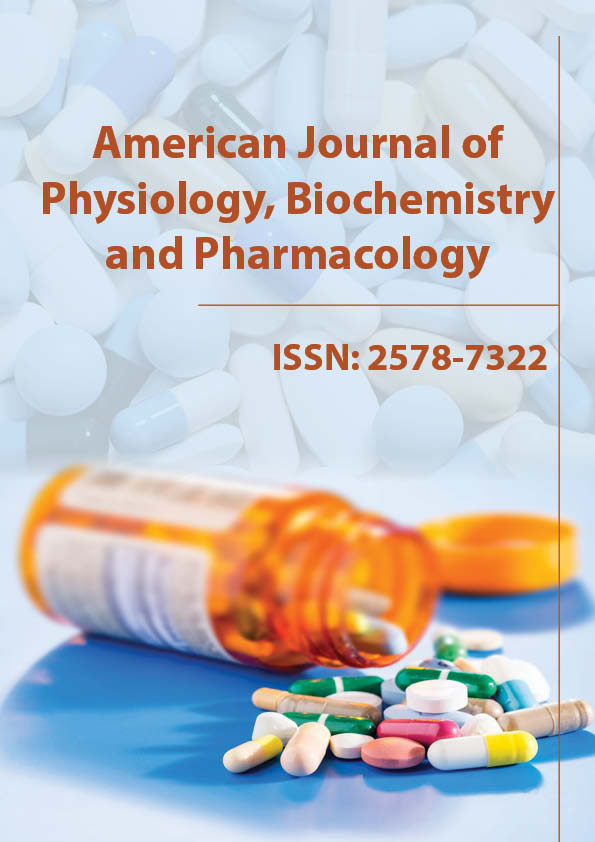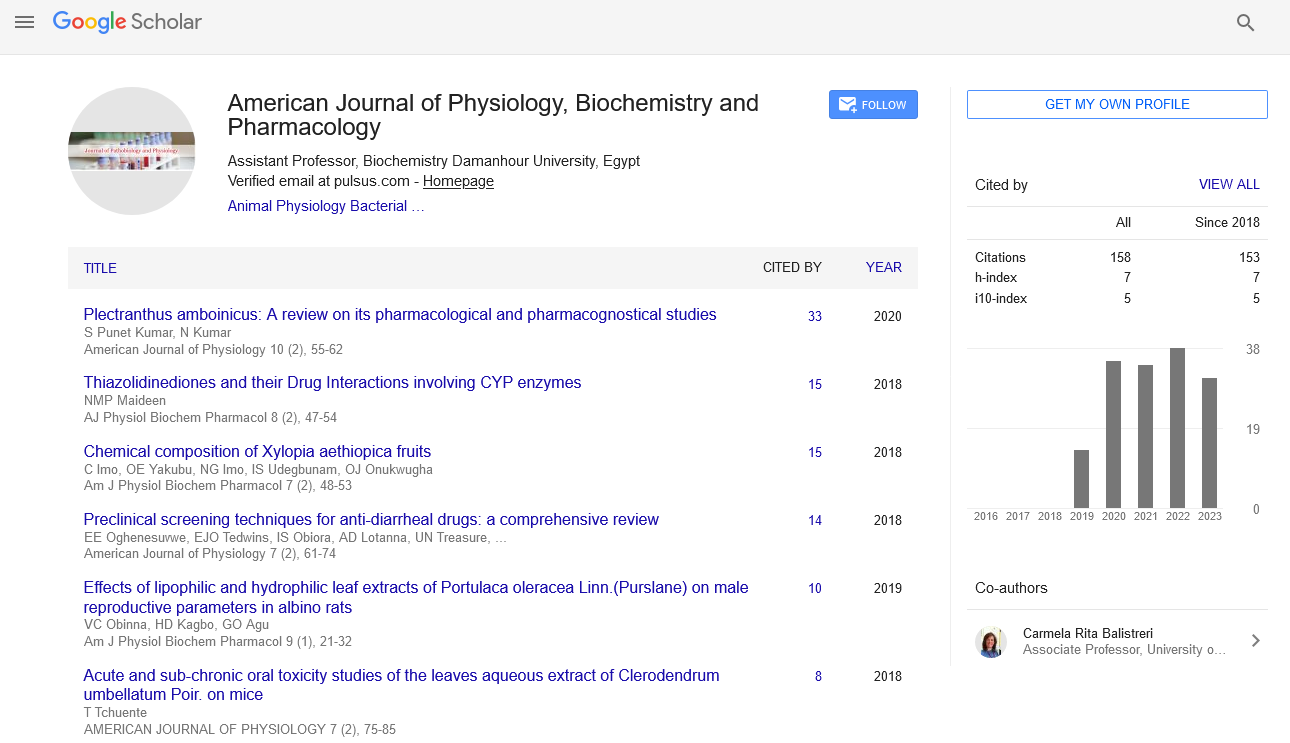Short Communication - American Journal of Physiology, Biochemistry and Pharmacology (2024)
Intricate Symphony of Cardiovascular Physiology and its Diseases
Matthew Stollman*Matthew Stollman, Department of physiology, North-western University Feinberg School of Medicine, Chicago, USA, Email: mstollman@uhrc.edu
Received: 23-Aug-2024, Manuscript No. AJPBP-24-148472; Editor assigned: 26-Aug-2024, Pre QC No. AJPBP-24-148472 (PQ); Reviewed: 09-Sep-2024, QC No. AJPBP-24-148472; Revised: 16-Sep-2024, Manuscript No. AJPBP-24-148472 (R); Published: 24-Sep-2024
Description
Cardiovascular physiology is a vital area within medical and biological sciences dedicated to understanding the functions and mechanisms of the cardiovascular system, which encompasses the heart, blood vessels, and blood. This system is essential for maintaining homeostasis, supplying oxygen and nutrients to tissues, eliminating metabolic waste, and regulating body temperature. A thorough grasp of cardiovascular physiology is crucial for the diagnosis and treatment of cardiovascular diseases, which remain a leading cause of illness and death globally [1-3].
Anatomy of the cardiovascular system
At the core of the cardiovascular system lies the heart, a muscular organ tasked with pumping blood throughout the body. The heart consists of four chambers: the right atrium and ventricle, which collect deoxygenated blood from the body and pump it to the lungs; and the left atrium and ventricle, which receive oxygenated blood from the lungs and distribute it throughout the body [4,5]. The cardiac cycle, which includes systole (contraction) and diastole (relaxation), is essential to the heart’s function and the overall cardiovascular system. Arteries transport oxygen-rich blood away from the heart, while veins return deoxygenated blood.
Hemodynamics
Hemodynamics refers to the study of blood flow and its dynamics within the cardiovascular system. Blood flow is influenced by several factors, including blood pressure, vascular resistance, and blood viscosity. Regulating blood pressure is a critical component of cardiovascular physiology, shaped by neural, hormonal, and intrinsic factors.
The autonomic nervous system plays a significant role in regulating heart rate and vascular tone. Sympathetic stimulation boosts heart rate and contractility, while parasympathetic stimulation slows heart rate. Hormones such as adrenaline and norepinephrine also influence cardiovascular responses during stress or physical activity. Additionally, the kidneys help regulate blood volume and pressure through the renin-angiotensinaldosterone system, maintaining homeostasis [6- 8].
Cardiac function and the Frank-Starling law
Cardiac function can be characterized by several key parameters, including stroke volume, cardiac output, and ejection fraction. Stroke volume refers to the volume of blood ejected by the heart with each contraction, while cardiac output is the total volume of blood pumped by the heart per minute. Ejection fraction is the percentage of blood pumped out of the ventricle relative to its total volume and serves as a critical measure of heart efficiency [9].
The Frank-Starling law of the heart posits that the force of contraction is directly related to the degree of ventricular filling (preload). In simple terms, the more the heart muscle is stretched by incoming blood, the stronger the contraction will be.
Impact of exercise on cardiovascular physiology
Physical exercise significantly impacts cardiovascular physiology. Regular aerobic activity promotes adaptations such as increased cardiac output, enhanced vascular function, and improved oxygen delivery to tissues. These changes result from structural adaptations in the heart, including ventricular hypertrophy (thickening of the heart muscle), increased capillary density, and improved endothelial function [10].
During exercise, the cardiovascular system must respond to the heightened metabolic demands of working muscles. This is achieved through elevated heart rate, increased stroke volume, and the redistribution of blood flow to active tissues, while diverting blood from non-essential areas, such as the gastrointestinal tract.
Cardiovascular pathophysiology
A thorough understanding of cardiovascular physiology is essential for addressing various cardiovascular diseases, including hypertension, coronary artery disease, heart failure, and arrhythmias. Pathophysiological changes in cardiovascular function can lead to serious health complications. For example, untreated hypertension can cause arterial damage, left ventricular hypertrophy, and ultimately heart failure. Similarly, atherosclerosis can reduce blood flow and heighten the risk of heart attacks and strokes.
Conclusion
In summary, cardiovascular physiology is a dynamic and integrated field that combines knowledge of anatomy, hemodynamic, cardiac function, and physiological responses to exercise. Understanding these complex mechanisms is potential for comprehending cardiovascular health and disease. As research advances in this area, it promises to enhance diagnostic techniques, therapeutic strategies, and overall outcomes for individuals with cardiovascular conditions. The relationship between physiological principles and clinical applications remains a cornerstone of cardiovascular health management, underscoring the importance of this field in contemporary medicine.
References
- Kline RM, Kline JJ, Di Palma J, Barbero GJ. Enteric-coated, pH-dependent peppermint oil capsules for the treatment of irritable bowel syndrome in children. J Pediatr. 2001;138(1):125-128.
[Crossref] [Google Scholar] [Pubmed].
- Massironi S, Cavalcoli F, Rausa E, Invernizzi P, Braga M, Vecchi M. Understanding short bowel syndrome: Current status and future perspectives. Dig Liver Dis. 2020;52(3):253-261.
[Crossref] [Google Scholar] [Pubmed].
- Buchman AL, Scolapio J, Fryer J. AGA technical review on short bowel syndrome and intestinal transplantation. Gastroenterology. 2003;124(4):1111-1134.
[Crossref] [Google Scholar] [Pubmed].
- Scolapio JS. Short bowel syndrome: recent clinical outcomes with growth hormone. Gastroenterology. 2006;130(2):S122-S126.
[Crossref] [Google Scholar] [Pubmed].
- Spencer AU, Neaga A, West B, Safran J, Brown P, Btaiche I, et al. Pediatric short bowel syndrome: Redefining predictors of success. Ann Surg. 2005;242(3):403.
[Crossref] [Google Scholar] [Pubmed].
- Vanderhoof JA, Langnas AN. Short-bowel syndrome in children and adults. Gastroenterology. 1997;113(5):1767-1778.
[Crossref] [Google Scholar] [Pubmed].
- Gura KM, Duggan CP, Collier SB, Jennings RW, Folkman J, Bistrian BR, et al. Reversal of parenteral nutrition–associated liver disease in two infants with short bowel syndrome using parenteral fish oil: implications for future management. Pediatrics. 2006;118(1):e197-e201.
[Crossref] [Google Scholar] [Pubmed].
- Jeejeebhoy KN. Management of short bowel syndrome: avoidance of total parenteral nutrition. Gastroenterology. 2006;130(2):S60-S66.
[Crossref] [Google Scholar] [Pubmed].
- Kuck KH. Arrhythmias and sudden cardiac death in the COVID-19 pandemic. Herz. 2020; 45(4):325-326.
[Crossref] [Google Scholar] [Pubmed].
- Mehra R. Global public health problem of sudden cardiac death. J Electrocardiol. 2007;40(6):S118- S122.
[Crossref] [Google Scholar] [Pubmed].






